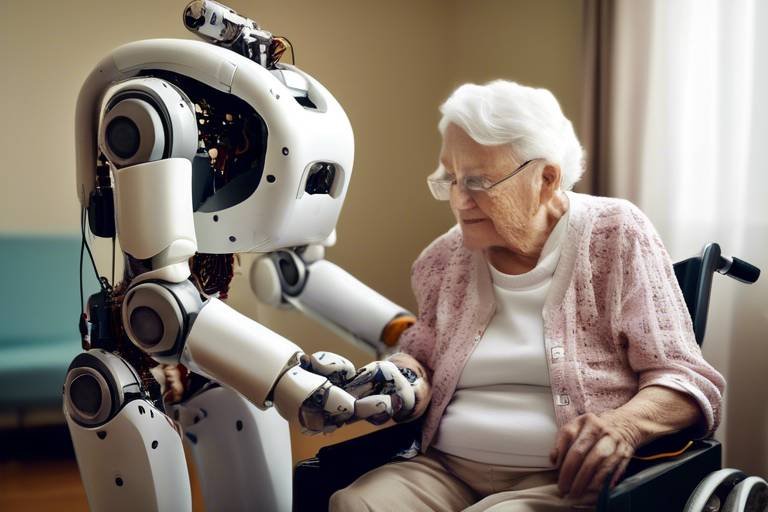The Impact of Robotics in Elder Care
In recent years, the integration of robotics into elder care has sparked a revolution that is transforming how we approach the care of our senior population. As the demand for elder care continues to rise, driven by an aging population, robotics offers innovative solutions that not only enhance the quality of life for seniors but also alleviate some of the burdens faced by caregivers and healthcare systems. Imagine a world where technology works hand-in-hand with human compassion, creating a harmonious environment that fosters independence and well-being for our elderly loved ones.
The impact of robotics in elder care is multifaceted, encompassing a variety of technologies ranging from simple assistive devices to advanced companionship robots. These robots are designed to perform tasks that can help seniors maintain their independence while ensuring they receive the support they need. For instance, robotic systems can assist with mobility, medication management, and even provide social interaction, which is crucial for mental health. The goal is not to replace human caregivers but to enhance their capabilities and allow them to focus on what truly matters: providing compassionate care.
Moreover, as we delve deeper into the world of robotics, it becomes evident that these technologies are not merely tools; they are companions that can significantly improve the overall well-being of elderly individuals. By offering emotional support and practical assistance, robotics can bridge the gap between isolation and community, ensuring that seniors feel connected and valued. The potential for robotics in elder care is vast, and as technology continues to evolve, so too will the ways in which we care for our aging population.
- What types of robots are used in elder care?
There are various types of robots, including companionship robots, mobility aids, and assistive devices for daily tasks. - How do companionship robots benefit seniors?
They provide emotional support, reduce feelings of loneliness, and can improve mental health outcomes. - Are there any challenges to implementing robotics in elder care?
Yes, challenges include high costs, user acceptance, and trust issues among seniors. - Can robots really replace human caregivers?
No, robots are designed to assist and enhance the work of human caregivers, not replace them.

Introduction to Robotics in Elder Care
In recent years, the realm of elder care has witnessed a remarkable transformation, primarily driven by the integration of robotics. These innovative technologies are not just futuristic concepts; they are becoming an essential part of how we care for our aging population. The essence of robotics in elder care lies in its ability to bridge the gap between human needs and technological capabilities, providing solutions that enhance the quality of life for seniors and support caregivers.
Robots designed for elder care can be categorized into several types, each serving unique functions tailored to the needs of older adults. Some of the most common types include:
- Companionship Robots: These robots are primarily focused on providing emotional support and reducing feelings of loneliness among seniors.
- Assistive Robots: These devices are designed to help with daily activities such as bathing, dressing, and meal preparation, promoting independence.
- Telepresence Robots: These allow healthcare professionals to interact with seniors remotely, ensuring they receive timely medical care.
- Medication Management Robots: These robots help seniors manage their medications, reminding them to take their pills and even dispensing the correct dosages.
Each of these robots plays a pivotal role in reshaping elder care. For instance, companionship robots not only provide a friendly face but also engage seniors in conversation, helping to stave off feelings of isolation. Meanwhile, assistive robots enable seniors to maintain their independence, allowing them to perform daily tasks with greater ease and safety. The emergence of telepresence robots has also revolutionized the way healthcare is delivered, making it easier for medical professionals to monitor and interact with patients without being physically present.
Moreover, the impact of robotics extends beyond just physical assistance. These technologies are designed with advanced features that cater to the emotional and psychological needs of seniors. By fostering connections and providing support, robotics can significantly enhance the overall well-being of elderly individuals. As we delve deeper into the potential of robotics in elder care, it's clear that these innovations are not merely tools; they are companions, assistants, and, most importantly, enablers of a better quality of life for our seniors.
In conclusion, the introduction of robotics into elder care is a game-changer. It promises not only to alleviate the pressures faced by caregivers but also to enrich the lives of seniors. As we continue to explore the benefits and challenges of these technologies, one thing is certain: the future of elder care is bright, and robotics is at the forefront of this revolution.

Benefits of Robotic Assistance
The integration of robotics into elder care is not just a passing trend; it’s a revolution that brings with it a plethora of benefits designed to enhance the quality of life for seniors. Imagine a world where elderly individuals can maintain their independence while receiving the support they need. Robotic assistance is making this vision a reality. These technologies are not merely machines; they are companions, caregivers, and vital resources that help seniors navigate the complexities of daily life. From providing companionship to assisting with mobility and medication management, the advantages of robotic assistance are profound.
One of the most significant benefits of robotic assistance is the ability to offer companionship. Many seniors experience feelings of loneliness and isolation, especially when family members are not around. Companionship robots are designed to engage with users, providing interaction that can alleviate these feelings. They can initiate conversations, share stories, and even play games, creating a sense of connection that is crucial for emotional well-being. Studies have shown that regular interaction with these robots can lead to a noticeable decrease in feelings of loneliness among elderly users.
Additionally, robotic assistance extends to mobility support. For seniors who may struggle with physical tasks, assistive robots can help with walking, standing, or even transferring from a bed to a chair. These robots are equipped with sensors and advanced technology to ensure safety, reducing the risk of falls and injuries. This not only promotes independence but also provides peace of mind for both seniors and their families. Imagine a robot that can help you stand up without any strain or assist you in walking through your home safely—this is the reality that robotic assistance offers.
Another area where robotic assistance shines is in medication management. Adhering to medication schedules can be challenging for many seniors, leading to missed doses or incorrect medication intake. Robots designed for this purpose can remind users when it’s time to take their medication, dispense the right doses, and even alert caregivers if something seems amiss. This proactive approach not only enhances the health of elderly individuals but also alleviates some of the burdens on caregivers, allowing them to focus on providing emotional support and companionship.
In summary, the benefits of robotic assistance in elder care are multifaceted. They provide companionship, support mobility, and ensure proper medication management, all of which contribute to a higher quality of life for seniors. By integrating these technologies into elder care, we are not just improving the daily routines of elderly individuals; we are empowering them to live with dignity and independence.
- What types of robots are commonly used in elder care?
Common types include companionship robots, mobility assistance robots, and medication management robots, each designed to address specific needs of seniors.
- Are companionship robots effective in reducing loneliness?
Yes, studies have shown that companionship robots can significantly reduce feelings of loneliness and improve emotional well-being among seniors.
- How do assistive robots help with mobility?
Assistive robots can provide physical support, helping seniors stand, walk, and perform daily activities safely, thus promoting independence.
- Can robotic assistance replace human caregivers?
While robots can assist with many tasks, they are not meant to replace human caregivers but rather to complement their efforts and improve overall care.

Companionship Robots
In a world where loneliness can feel like a heavy blanket draped over one's shoulders, emerge as a beacon of hope for many seniors. These innovative machines are designed not just to assist but to connect, offering emotional support that can significantly enhance the quality of life for elderly individuals. Imagine a friendly robot that can engage in conversation, play games, or even remind you of important events—this is the reality of companionship robots.
Companionship robots are equipped with advanced technologies that allow them to interact with users in a meaningful way. They can recognize faces, respond to voice commands, and even learn preferences over time, creating a personalized experience for each user. This level of interaction is crucial for seniors who may feel isolated, as it fosters a sense of belonging and connection. The emotional benefits of these robots cannot be overstated; they serve as a bridge to combat feelings of loneliness and depression that often plague the elderly.
One of the standout features of companionship robots is their ability to facilitate social interaction. Many of these robots come loaded with a variety of games and activities designed to engage users cognitively and socially. For instance, they can play trivia games, tell jokes, or even lead a user through a guided meditation. This not only keeps the mind sharp but also encourages seniors to interact more, reducing the risk of social isolation. Think of it like having a friendly neighbor who always has a fun activity planned!
Research has shown that the presence of companionship robots can lead to a noticeable improvement in mental health. Seniors who regularly engage with these robots often report lower levels of anxiety and depression. In fact, studies indicate that the emotional support provided by these robots can be comparable to that of human interaction. This is particularly significant for those who may have lost loved ones or are unable to participate in social gatherings. The robots become companions, providing not just entertainment but also a sense of purpose and connection.
In conclusion, companionship robots are more than just gadgets; they are lifelines for many seniors. They offer a unique blend of companionship and support, helping to alleviate loneliness and enhance emotional well-being. As technology continues to evolve, we can expect these robots to become even more sophisticated, further enriching the lives of elderly individuals and transforming the landscape of elder care.

Social Interaction Features
Social interaction features in companionship robots are truly revolutionary, offering seniors a lifeline to the outside world. Imagine a lonely elderly person sitting at home, feeling disconnected from family and friends. Now, picture a friendly robot entering their life, equipped with the ability to engage in meaningful conversations, play games, and even share stories. These robots are not just machines; they are designed to be companions, providing a sense of presence and warmth that can significantly enhance the quality of life for seniors.
One of the standout features of these robots is their conversational capabilities. Advanced natural language processing allows them to understand and respond to various topics, making interactions feel more organic. For example, a robot might ask a senior about their favorite hobbies or reminisce about past experiences, sparking joy and nostalgia. This kind of engagement is crucial as it helps to combat feelings of isolation and loneliness, which are prevalent among the elderly.
Moreover, many companionship robots come equipped with interactive games and activities that promote cognitive engagement. These activities can range from simple puzzles to more complex games that encourage critical thinking and memory recall. By participating in these interactive sessions, seniors not only enjoy themselves but also stimulate their minds, which can be beneficial in maintaining cognitive health.
To illustrate the variety of social interaction features, here’s a quick comparison of some popular companionship robots:
| Robot Name | Key Features | Social Interaction Capabilities |
|---|---|---|
| Paro | Therapeutic seal robot | Responds to touch, provides comfort |
| Jibo | Social robot | Engages in conversation, plays games |
| Woobo | Interactive plush robot | Storytelling, educational games |
These robots not only provide entertainment but also serve as a bridge for seniors to connect with their loved ones. Many models feature video calling capabilities, allowing family members to check in and chat with their elderly relatives easily. This connection can be a game-changer, as it helps to maintain relationships and ensures that seniors feel valued and loved.
In conclusion, the social interaction features of companionship robots are more than just technological advancements; they are vital tools that foster emotional well-being and social engagement among seniors. By providing companionship and stimulating interaction, these robots play a significant role in enhancing the overall quality of life for elderly individuals, making them feel less isolated and more connected to the world around them.
- What are companionship robots? Companionship robots are designed to provide emotional support and social interaction for seniors, helping to alleviate feelings of loneliness.
- How do these robots enhance social interaction? They engage users in conversation, play games, and facilitate video calls with family members, promoting connectivity.
- Are companionship robots effective in improving mental health? Yes, research shows that they can help reduce depression and anxiety by providing companionship and stimulating engagement.

Impact on Mental Health
The impact of robotics on mental health, especially for the elderly, is nothing short of revolutionary. Imagine waking up in the morning and having a friendly robot companion greet you, reminding you of your favorite activities or even sharing a joke. This is the reality for many seniors who have embraced companionship robots. Research has shown that these robots can significantly alleviate feelings of loneliness and depression, which are common among older adults. The emotional support provided by these robotic companions can lead to a more fulfilling and happy life.
Studies indicate that seniors who interact with companionship robots experience a decline in symptoms associated with anxiety and depression. For instance, a recent study found that 70% of participants reported feeling less lonely after just a few weeks of using a companionship robot. This is a remarkable statistic that highlights the potential of technology to enhance emotional well-being. Moreover, the robots often engage users in activities that stimulate their cognitive functions, such as playing games or solving puzzles, which can further improve mental health.
But how exactly do these robots contribute to better mental health? Here are a few key aspects:
- Emotional Connection: Many companionship robots are designed to recognize and respond to human emotions, providing a sense of understanding and empathy that can be comforting for seniors.
- Consistent Interaction: Regular interaction with a robot can create a routine, which is essential for mental stability. It gives seniors something to look forward to each day.
- Reduced Isolation: By providing companionship, these robots help combat social isolation, which is a significant risk factor for mental health issues in older adults.
Furthermore, it’s important to consider that these robots can also serve as a bridge to human interaction. They can encourage seniors to engage more with their family members or caregivers by facilitating conversations and activities that involve others. For example, a robot might suggest a family game night or remind seniors to call their loved ones, effectively fostering connections that might otherwise weaken over time.
In conclusion, the integration of robotics into elder care is not just about providing physical assistance; it is also about enhancing mental health and emotional well-being. As technology continues to evolve, it is exciting to think about the future possibilities of how robots can support our elderly loved ones, making their golden years not just bearable, but truly enjoyable.
- What types of robots are used in elder care?
Robots used in elder care include companionship robots, assistive robots for daily activities, and telepresence robots for remote interaction. - How do companionship robots help with loneliness?
Companionship robots provide emotional support, engage in conversations, and encourage activities that can reduce feelings of isolation. - Are companionship robots effective in improving mental health?
Yes, studies have shown that companionship robots can significantly reduce symptoms of depression and anxiety among seniors. - What are the costs associated with robotic assistance?
The costs can vary widely depending on the type of robot and its functions, but funding options may be available for families and care facilities.

Assistive Robots for Daily Activities
Imagine waking up each morning and having a personal assistant ready to help you with your daily tasks. Assistive robots are revolutionizing the way seniors manage their everyday activities, transforming the often overwhelming challenges of aging into manageable tasks. These robots are designed to assist with various daily activities such as bathing, dressing, and meal preparation, allowing elderly individuals to maintain a level of independence that might otherwise be lost.
One of the most significant benefits of assistive robots is their ability to promote independence. For many seniors, the simple act of dressing or preparing a meal can become daunting due to physical limitations. Robots equipped with advanced sensors and mobility features can help with these tasks, making them feel more confident and capable. For instance, a robot can assist a senior in getting dressed by providing support when standing or reaching for clothing items, effectively reducing the risk of falls and injuries.
In addition to physical assistance, these robots often come with user-friendly interfaces that make them easy to operate. Many models are equipped with voice recognition technology, allowing seniors to give commands simply by speaking. This feature is particularly beneficial for those who may struggle with fine motor skills or have difficulty using traditional devices. Imagine being able to say, "Robot, prepare my breakfast," and having a machine respond by fetching ingredients and cooking a meal. It’s like having a personal chef at your service!
Moreover, assistive robots can also be programmed to remind seniors to take their medications, ensuring they stay on track with their health regimens. These reminders can be delivered in various forms, such as voice alerts or visual cues, making it easier for seniors to adhere to their prescribed schedules. This capability is crucial, as medication mismanagement can lead to serious health complications.
However, it's important to recognize that the integration of assistive robots into daily life isn't without its challenges. Some seniors may feel overwhelmed by technology, leading to reluctance in adopting these helpful devices. To address this, caregivers and family members can play a vital role in introducing these robots gradually, allowing seniors to become familiar with their functionalities in a comfortable setting.
In conclusion, assistive robots are not just machines; they are companions that enhance the quality of life for seniors. By promoting independence, ensuring safety, and providing essential reminders, these robots are paving the way for a future where aging individuals can thrive in their own homes. As technology continues to evolve, the potential for assistive robots to change the landscape of elder care will only grow, making it an exciting time for both seniors and their caregivers.
- What types of tasks can assistive robots perform? Assistive robots can help with daily tasks such as bathing, dressing, meal preparation, and medication reminders.
- Are assistive robots easy to use? Yes, most assistive robots are designed with user-friendly interfaces and voice recognition technology to make them accessible for seniors.
- Can assistive robots improve safety for seniors? Absolutely! By providing physical support and reminders, these robots can significantly reduce the risk of falls and injuries.
- How can family members help seniors adapt to assistive robots? Family members can introduce robots gradually, provide demonstrations, and encourage seniors to ask questions to build comfort and familiarity.

Challenges and Limitations
While the integration of robotics into elder care is a groundbreaking development, it is not without its . One of the most significant hurdles is the cost of implementation. The initial investment required for advanced robotic systems can be substantial, often making it difficult for care facilities and families to adopt these technologies. For instance, the price of a single assistive robot can range from $10,000 to over $100,000, depending on its capabilities and features. This financial burden can deter many potential users from embracing robotic solutions, leaving them reliant on traditional caregiving methods that may not be as efficient or effective.
Furthermore, there are ongoing costs associated with maintenance, updates, and training staff to use these technologies effectively. In many cases, funding options are limited, and facilities may struggle to secure the necessary financial support. To illustrate this point, consider the following table that outlines the typical costs associated with robotic systems:
| Type of Robot | Initial Cost | Annual Maintenance Cost |
|---|---|---|
| Companionship Robot | $5,000 - $20,000 | $500 - $2,000 |
| Assistive Robot | $10,000 - $100,000 | $1,000 - $5,000 |
| Medication Management Robot | $15,000 - $50,000 | $800 - $3,000 |
Another critical challenge revolves around user acceptance and trust. Many seniors may feel apprehensive about interacting with robots, stemming from a sense of unfamiliarity or skepticism about their capabilities. This hesitance can significantly impact the effectiveness of robotic systems in elder care. To address this issue, it is essential to implement strategies that build trust and familiarity with these technologies. For example, caregivers can introduce robots gradually, allowing seniors to become accustomed to their presence and functionalities. Engaging in training sessions that demonstrate the robots' benefits can also help alleviate fears and foster a positive perception.
Additionally, it’s important to recognize that not all seniors are tech-savvy, and some may require more personalized assistance to adapt to robotic technologies. Caregivers play a crucial role in this transition, acting as intermediaries who can bridge the gap between technology and the elderly. By providing emotional support and encouragement, caregivers can help seniors see robots not as replacements but as valuable companions that enhance their quality of life.
In summary, while the integration of robotics in elder care holds immense potential, it is essential to address the challenges of cost and user acceptance. By developing comprehensive funding strategies and fostering trust through education and engagement, we can pave the way for a future where robotics significantly improve the lives of seniors and their caregivers.
- What types of robots are commonly used in elder care?
Common types include companionship robots, assistive robots for daily activities, and medication management robots.
- How can robotics improve the quality of life for seniors?
Robotics can provide companionship, assist with daily tasks, and help manage medication, all of which contribute to enhanced independence and well-being.
- Are there any risks associated with using robots in elder care?
Potential risks include the high cost of implementation and the challenge of gaining user acceptance and trust.

Cost of Implementation
When it comes to integrating robotics into elder care, one of the most significant hurdles is the . The financial investment required can be daunting for many care facilities and families. From the initial purchase of robotic systems to ongoing maintenance and training, the expenses can quickly add up. For instance, a single companionship robot can range from $1,000 to over $20,000, depending on its features and capabilities. This price tag often leaves many potential users pondering whether the benefits outweigh the costs.
Moreover, the costs don't stop at acquisition. Many robotic systems require regular updates and maintenance, which can further strain budgets. Facilities also need to consider the training costs for staff who will be operating these robots. It's not just about buying the technology; it’s about ensuring that everyone involved is equipped to use it effectively. In fact, a study indicated that nearly 30% of facilities reported higher operational costs due to the need for specialized staff training.
To put this into perspective, let’s look at a simple table that outlines some common costs associated with robotic systems in elder care:
| Cost Component | Estimated Cost |
|---|---|
| Initial Purchase | $1,000 - $20,000+ |
| Maintenance (Annual) | $500 - $2,000 |
| Staff Training | $200 - $1,500 |
| Software Updates | $100 - $500 |
Despite these costs, many facilities are exploring funding options to help offset the financial burden. Government grants, nonprofit funding, and partnerships with tech companies are just a few avenues being pursued. Additionally, some organizations are beginning to recognize the long-term savings that can arise from using robotics, such as reduced staffing needs and improved patient outcomes. In the end, while the initial investment may seem steep, the potential for enhanced care and increased efficiency could make it worthwhile.
As we navigate this new frontier in elder care, it’s essential to weigh both the costs and benefits carefully. The key is to find a balance that maximizes the potential of robotic assistance while also being mindful of financial constraints. After all, investing in the well-being of our elderly population is not just a financial decision; it's a moral imperative.
- What are the main costs associated with robotic systems in elder care? The main costs include the initial purchase price, maintenance, staff training, and software updates.
- Are there funding options available for implementing robotics in elder care? Yes, facilities can explore government grants, nonprofit funding, and partnerships with technology companies.
- How can facilities justify the costs of robotic systems? Facilities can consider long-term savings, improved patient outcomes, and enhanced efficiency as justifications for the investment.
- What is the price range for companionship robots? Companionship robots can range from $1,000 to over $20,000, based on their features and capabilities.

User Acceptance and Trust
When it comes to integrating robotics into elder care, one of the most significant hurdles is . Imagine being a senior who has spent a lifetime surrounded by human companionship, only to be met with a robot designed to help you with daily tasks. It’s no surprise that many seniors may feel hesitant or even skeptical about these technological advancements. Building trust is essential, as it directly influences the willingness of elderly individuals to embrace robotic assistance in their daily lives.
To foster acceptance, it’s crucial to understand the primary concerns that seniors may have. These can include:
- Fear of Replacement: Many seniors worry that robots might replace human caregivers, leading to feelings of isolation.
- Complexity of Technology: The perception that robots are complicated can deter seniors from using them.
- Privacy Concerns: With technology comes the fear of surveillance and loss of personal privacy.
Addressing these concerns requires a multi-faceted approach. First and foremost, education plays a vital role. By providing seniors with comprehensive training that demystifies robotic technology, they can become more comfortable and confident in using these tools. Workshops and demonstrations can help bridge the gap between unfamiliarity and acceptance. Furthermore, involving family members in the training process can create a supportive environment, making the transition smoother.
Another effective strategy is to involve seniors in the design process of robotic systems. When seniors feel that their opinions and needs are valued, it can significantly enhance their trust in the technology. For instance, companies developing elder care robots could conduct focus groups with seniors to gather feedback on features and functionalities. This not only empowers seniors but also results in products that are tailored to their specific needs.
Moreover, highlighting the benefits of robotic assistance can significantly impact acceptance. When seniors are made aware of how these robots can enhance their quality of life—be it through providing companionship, assisting with daily tasks, or ensuring their safety—they may be more inclined to embrace the technology. Testimonials from other seniors who have had positive experiences with robotic assistance can also serve as powerful motivators.
Finally, building a strong emotional connection is essential. Robots designed for elder care should incorporate features that promote empathy and understanding. For example, robots that can recognize and respond to emotional cues can create a sense of companionship and trust. This emotional engagement can help alleviate fears and promote a more positive outlook on the use of robotics in elder care.
In conclusion, while the road to user acceptance and trust in robotic assistance for elder care may be challenging, it is not insurmountable. By focusing on education, involvement, benefits, and emotional connection, we can pave the way for a future where seniors feel comfortable and supported by the technology designed to assist them.
Q1: Are robots safe for seniors to use?
A1: Yes, most elder care robots are designed with safety features to ensure they are user-friendly and safe for seniors.
Q2: How can I encourage my elderly loved one to accept robotic assistance?
A2: Educate them about the benefits, involve them in the selection process, and provide hands-on training to build their confidence.
Q3: Will robots replace human caregivers?
A3: No, robots are designed to assist human caregivers, not replace them. They can help with specific tasks, allowing caregivers to focus on more personal interactions.
Q4: What features should I look for in a companionship robot?
A4: Look for features that promote interaction, such as conversation capabilities, emotional recognition, and games to keep seniors engaged.
Frequently Asked Questions
- What types of robots are used in elder care?
Robots in elder care come in various forms, including companionship robots that provide emotional support, assistive robots that help with daily activities like bathing and dressing, and mobility aids that assist seniors with movement. Each type is designed to enhance the quality of life for seniors in different ways.
- How do companionship robots improve mental health for seniors?
Companionship robots can significantly reduce feelings of loneliness and isolation among seniors. By providing social interaction and emotional support, these robots help alleviate symptoms of depression and anxiety, leading to improved overall mental health and well-being.
- Are assistive robots safe for seniors to use?
Yes, assistive robots are designed with safety in mind. They often come equipped with sensors to detect obstacles and prevent accidents. Additionally, they promote independence by allowing seniors to perform daily tasks more safely, reducing the risk of falls or injuries.
- What are the main challenges of implementing robotic solutions in elder care?
One of the primary challenges is the high cost of robotic systems, which can be a barrier for many families and care facilities. Additionally, there may be resistance from seniors who are unfamiliar with technology, leading to trust issues. Addressing these challenges involves exploring funding options and providing education about the benefits of robotics.
- How can we improve user acceptance of robotic technologies among seniors?
Building trust is crucial for improving acceptance. This can be achieved through demonstrations, educational sessions, and involving seniors in the decision-making process when selecting robotic solutions. Personalizing the experience and showing how robots can enhance their daily lives can also foster a positive attitude towards these technologies.
- Can robots help with medication management for seniors?
Absolutely! Many robotic systems are equipped with features that remind seniors to take their medications at the right times. Some can even dispense the correct dosages, ensuring that seniors adhere to their medication schedules, which is vital for maintaining their health.
- What future advancements can we expect in robotics for elder care?
The future of robotics in elder care looks promising, with advancements in artificial intelligence and machine learning. We can expect more sophisticated robots that can better understand and respond to the needs of seniors, making them more intuitive and user-friendly. Enhanced social interaction capabilities and improved safety features are also on the horizon.



















